This recipe for homemade spinach ricotta ravioli with sage butter sauce touches all your senses. Yes, it takes a little time. But it’s a super satisfying meal to prepare, cook, and eat.
It starts with making a dough by hand (touch), followed by mixing the ingredients for the filling (sight). Next we assemble the ravioli. And finally, carefully melting some butter and crisping (hearing) some sage leaves to create a wonderful smelling (smell) sauce for these incredible tasty (taste) ravioli.
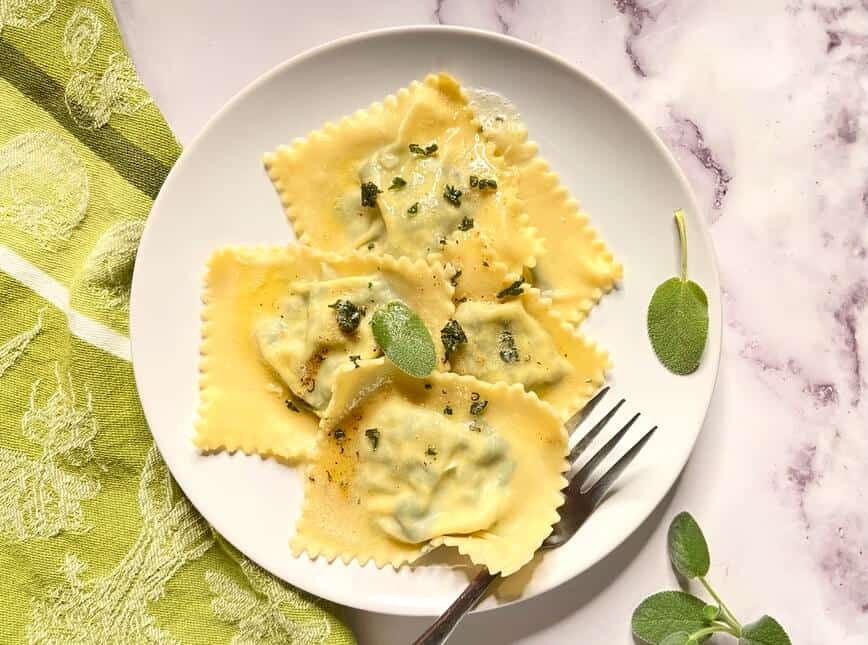
From starting the dough to sitting down to enjoy your creation takes about an hour. It’s an hour of pleasure gained in your life. As soon as you take the first bite, your mind will remember every step you used to create this wonderful meal - and your friends will be pretty happy, too.
Jump to:
- How to make homemade pasta dough
- 🧾 Pasta dough ingredients
- 📋 Equipment used to make pasta dough
- 🥣 How to make spinach ricotta (and parmesan cheese) filling
- 🫒 Ingredients for filling
- 🥄 Equipment used to make ravioli
- 🥟 How to make ravioli
- 🧈 Ingredients for the sauce
- 🌿 How to make sage butter sauce
- ✨ Tips for the sage butter sauce
- 😃 Fun facts about ravioli
- 📝 Recipe
How to make homemade pasta dough
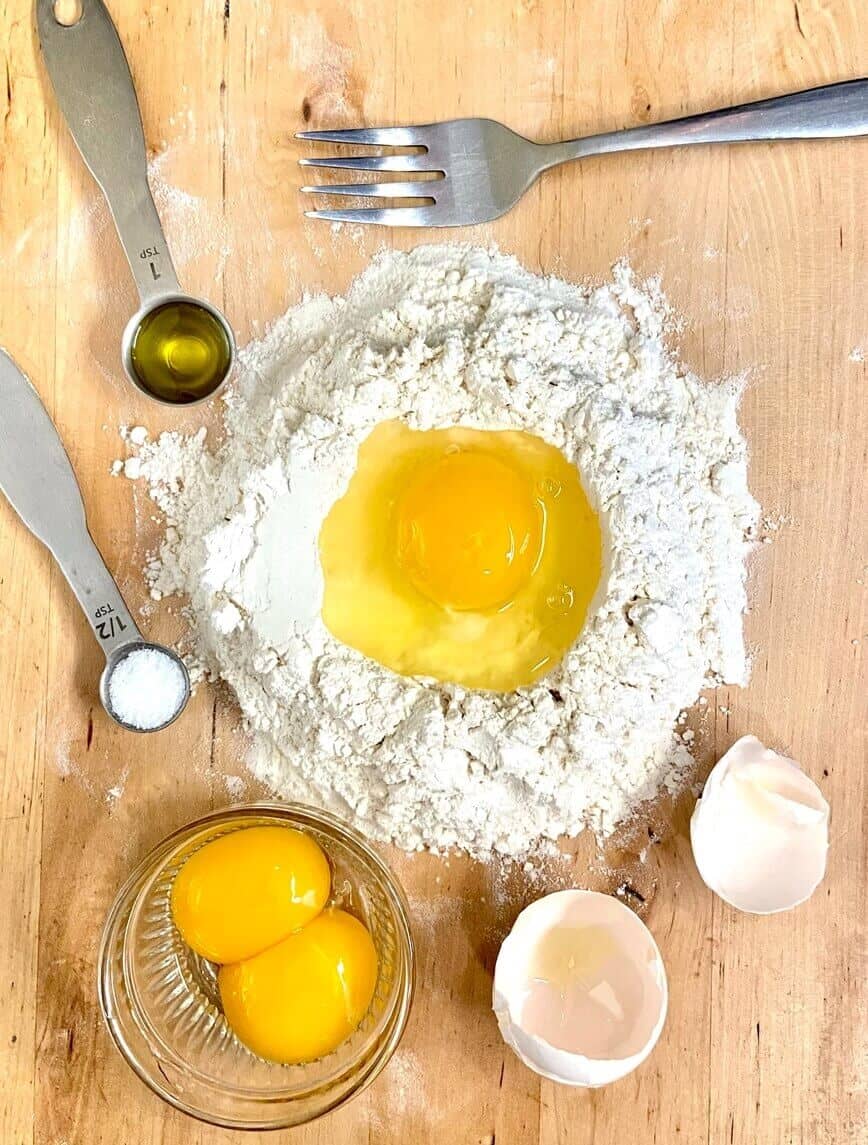
🧾 Pasta dough ingredients
- All purpose flour
- Eggs
- Kosher salt
- Extra virgin olive oil
See the recipe card below for full list of ingredients and their measurements.
📋 Equipment used to make pasta dough
- Flour sifter
- Dough scraper
- Pasta machine
Start by sifting the flour onto the surface. Create a well on top of the flour and crack an egg into it.
Also, lightly whisk two egg yolks in a small bowl and have them ready. Add the salt into the well and start mixing carefully with a fork, trying to keep the egg from running out of the well. Once the first egg is mostly incorporated into the flour, add the olive oil and the two egg yolks.
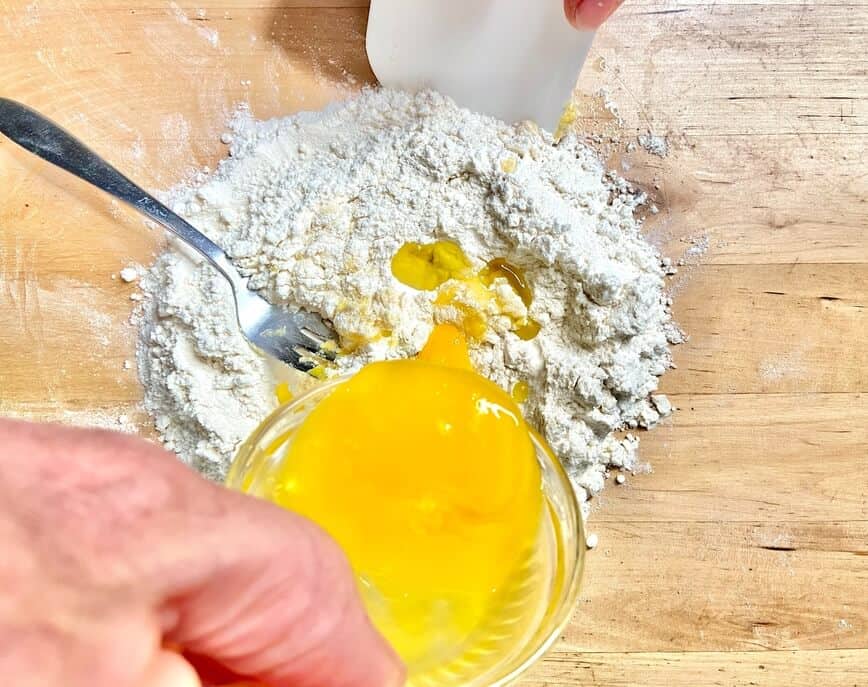
At this point, I like to use a food scraper to help work the flour toward the center to mix the dough until the egg yolks are mostly absorbed.
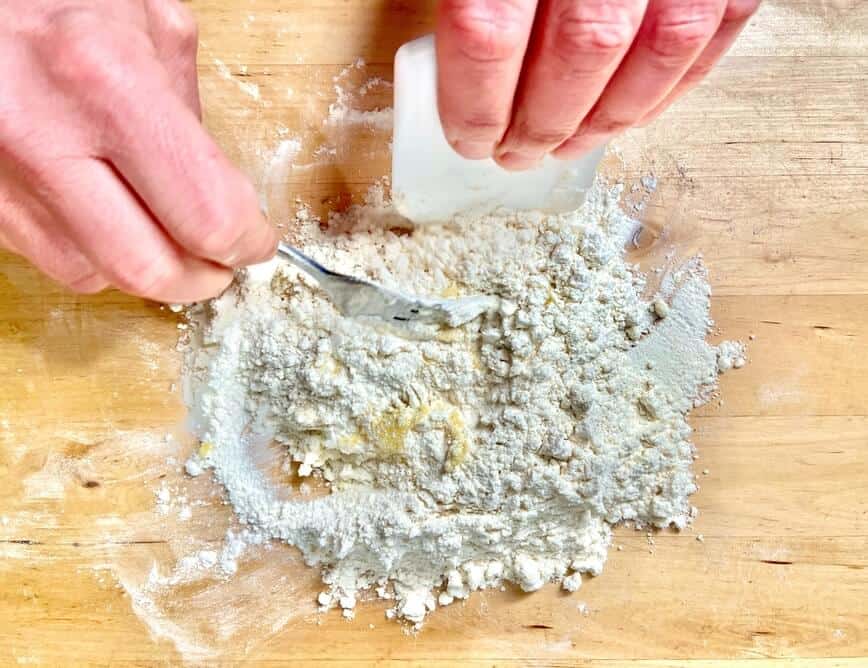
Next, sprinkle some flour into your hands and start kneading. The dough might seem a little dry at first. But be patient and keep kneading. If the dough still feels a little dry after about 3 minutes of working it, add a teaspoon or so of water and keep kneading for a few more minutes. Conversely, if it feels too wet, add a little flour.
The dough should be slightly on the dry side, otherwise it will stick to the pasta maker. When you push down on the dough with your finger, it should bounce back. Wrap in cling wrap and let rest at room temperature for about 30 minutes. This resting period allows the gluten to develop, to make the dough nice and elastic, and ensures that all the flour is well hydrated.
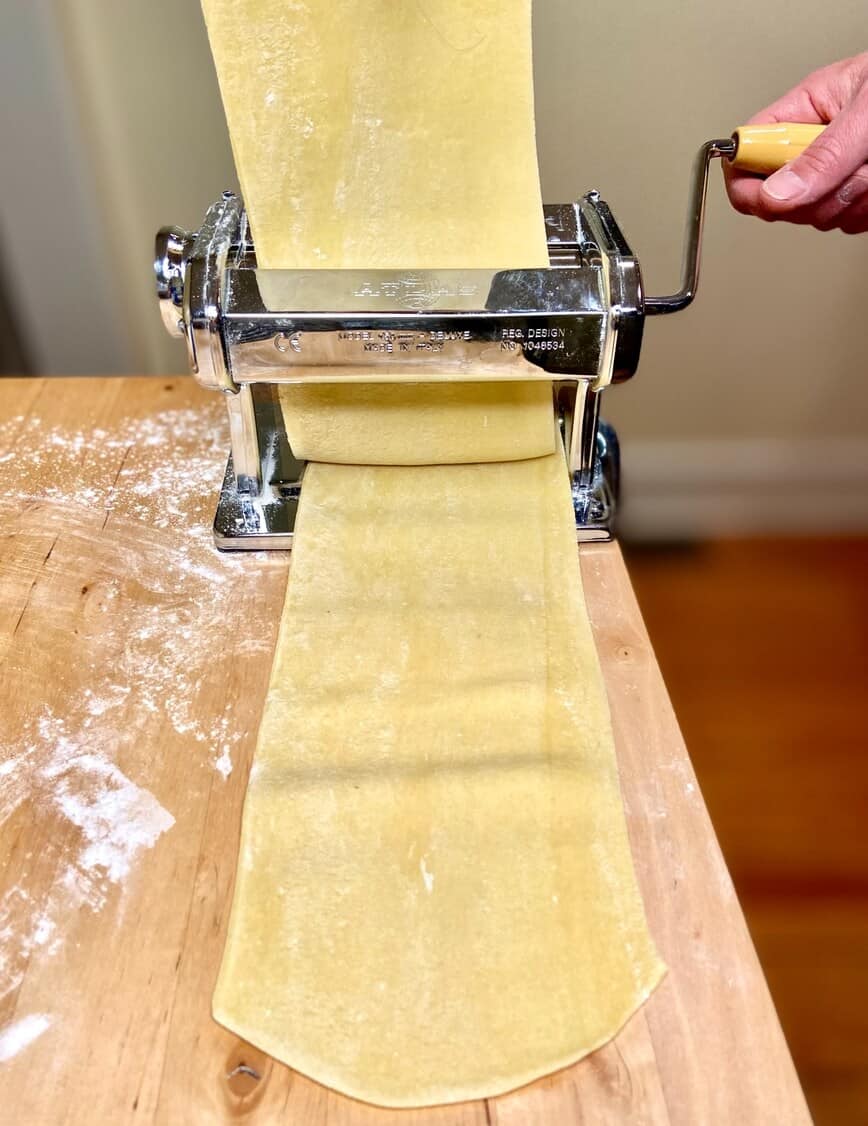
Next, cut the dough into quarters. Flatten each piece of dough slightly by pressing down with the palm of your hand and form it into a rectangular shape that will fit the width of the machine.
Set the rollers to the widest setting and roll the dough through. See how it feels. If it’s too moist, let it rest for a couple minutes. Otherwise, keep rolling the dough through the pasta maker, passing it through each setting twice. Keep decreasing the setting until reaching your desired thickness.
In the case of ravioli, you want to make sure to get to the smallest, thinnest setting, as the dough will be doubled when you fold it over. If the dough gets too long to handle, cut it in half. It’s incredible how much dough a cup of flour produces.
⭐ Tip: The above instructions work for any kind of pasta. If you’d like to make some nice tagliatelle instead, maybe stop before the smallest setting and manually cut them into strands.
🥣 How to make spinach ricotta (and parmesan cheese) filling
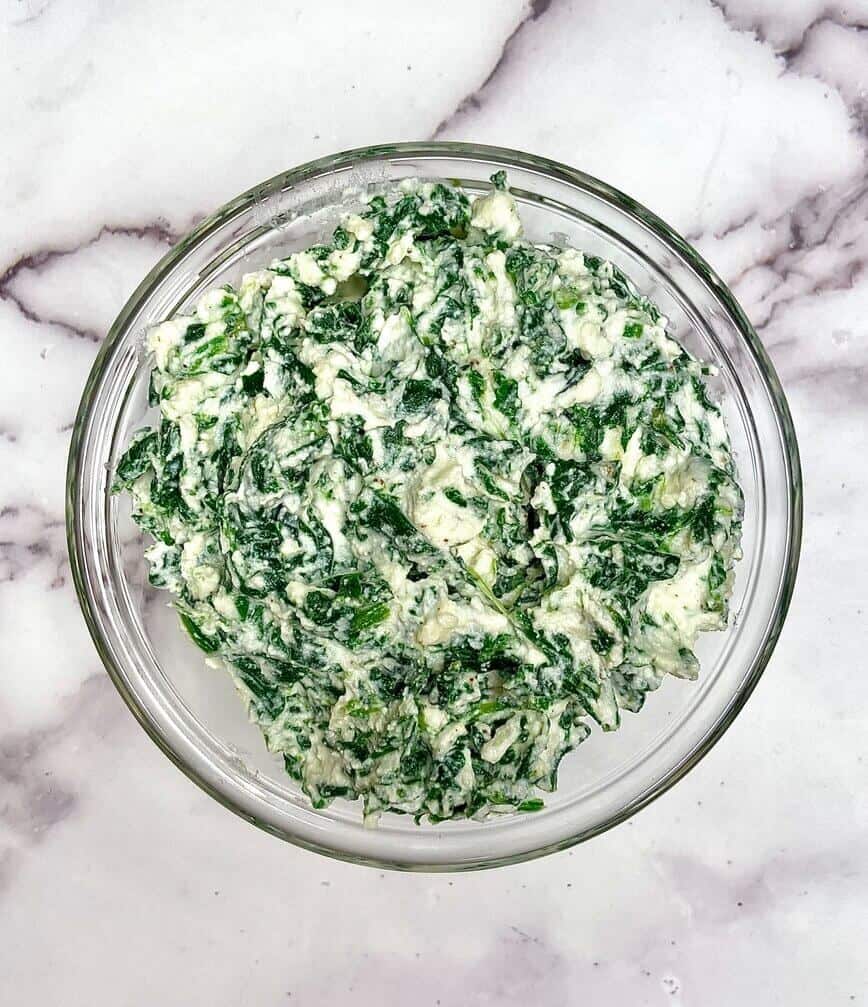
🫒 Ingredients for filling
- Extra virgin olive oil
- Fresh spinach
- Whole milk ricotta
- Parmigiano Reggiano
- Salt and pepper
See the recipe card below for full list of ingredients and their measurements.
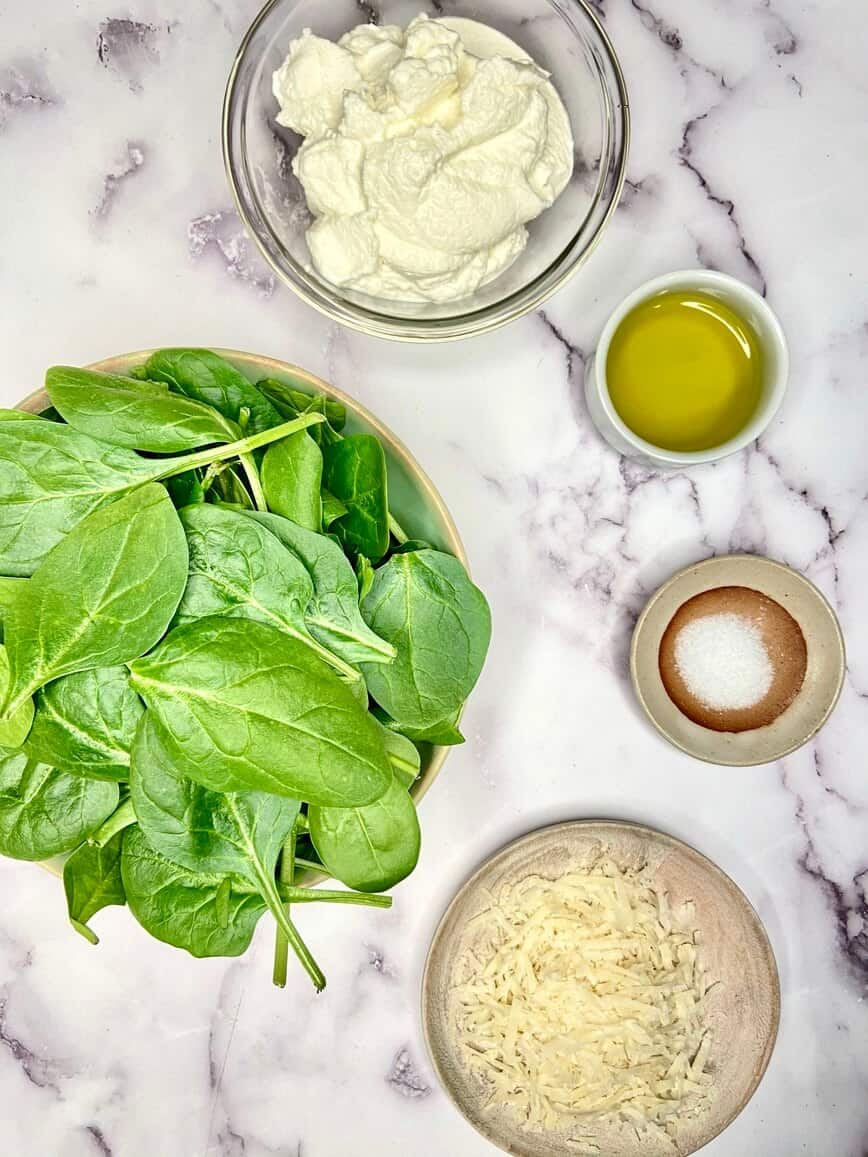
Use a pan that’s large enough to fit the fresh spinach. Heat olive oil over medium heat and add the spinach. Within a couple minutes - while stirring occasionally - your fresh spinach will shrink from a couple handfuls to less than a cup. This always amazes me.
When the spinach is cooked down, place in a colander and squeeze out as much water as you can. In addition to that, I place the spinach onto some paper towels to remove some more moisture.
Finely chop the spinach. Place the spinach in a bowl, together with the ricotta, Parmesan, salt, and pepper, and mix it all together.
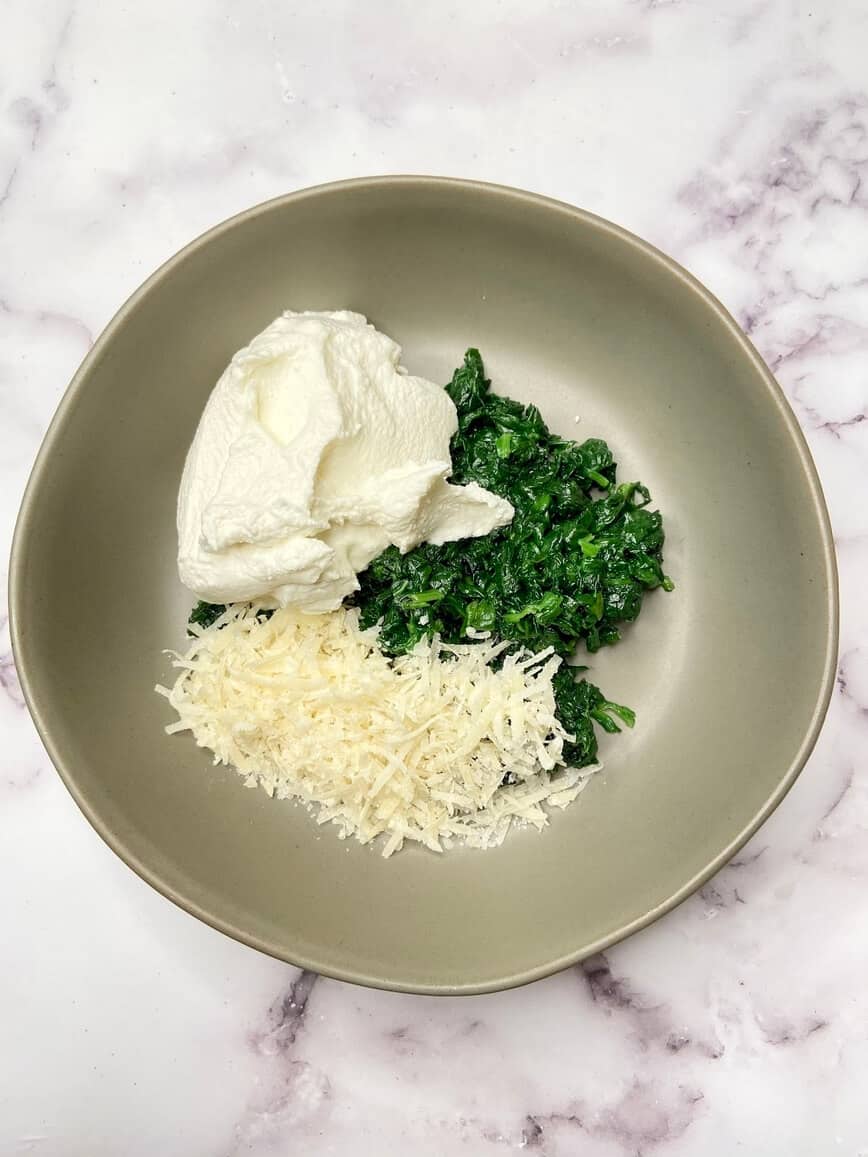
Taste and add more salt and/or pepper if necessary. The way your filling tastes right now is pretty much how your ravioli (without sauce) will taste.
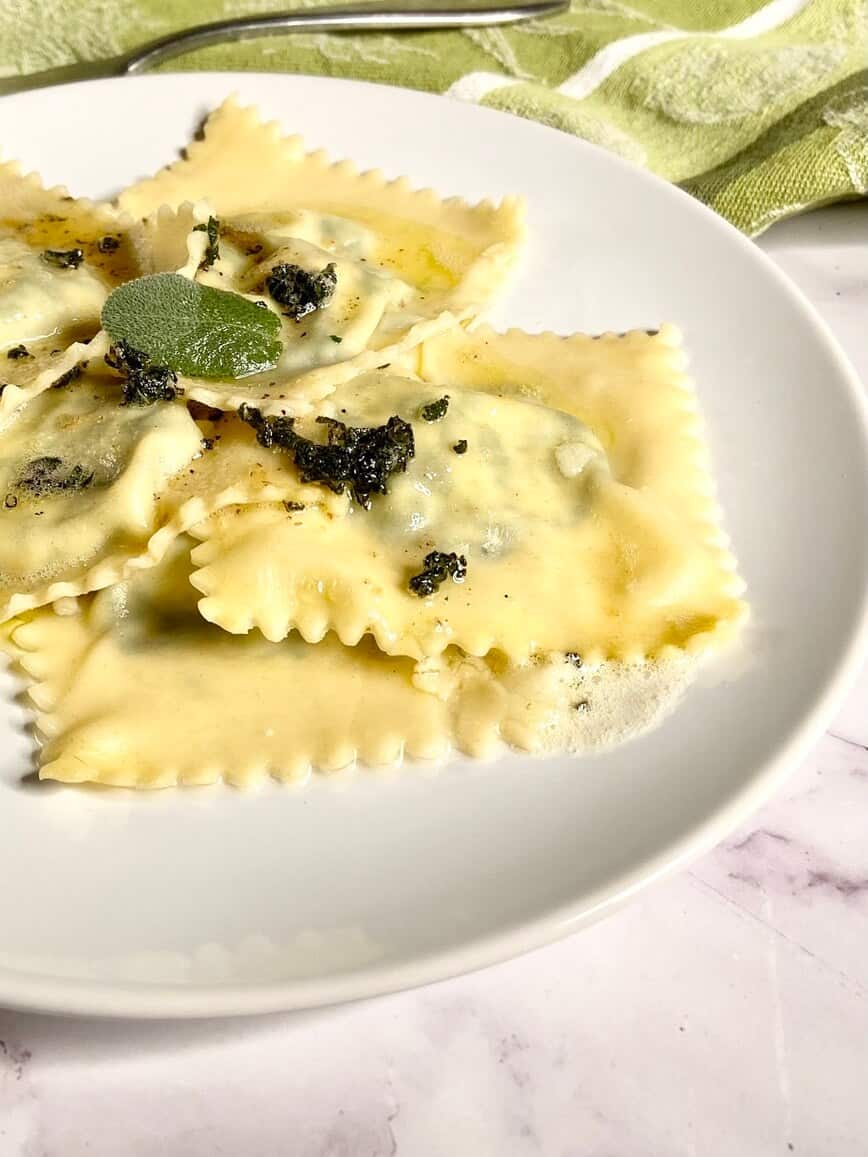
🥄 Equipment used to make ravioli
- Ravioli wheel
- Food spider
🥟 How to make ravioli
This is my favorite step. And the coolest thing about it is that every time you make them, the ravioli will look a little different. Heck, every ravioli will look a little different.
Place about 2 teaspoons of filling on the bottom half of the dough sheet. Leave about 1-½” of space between each scoop of filling.
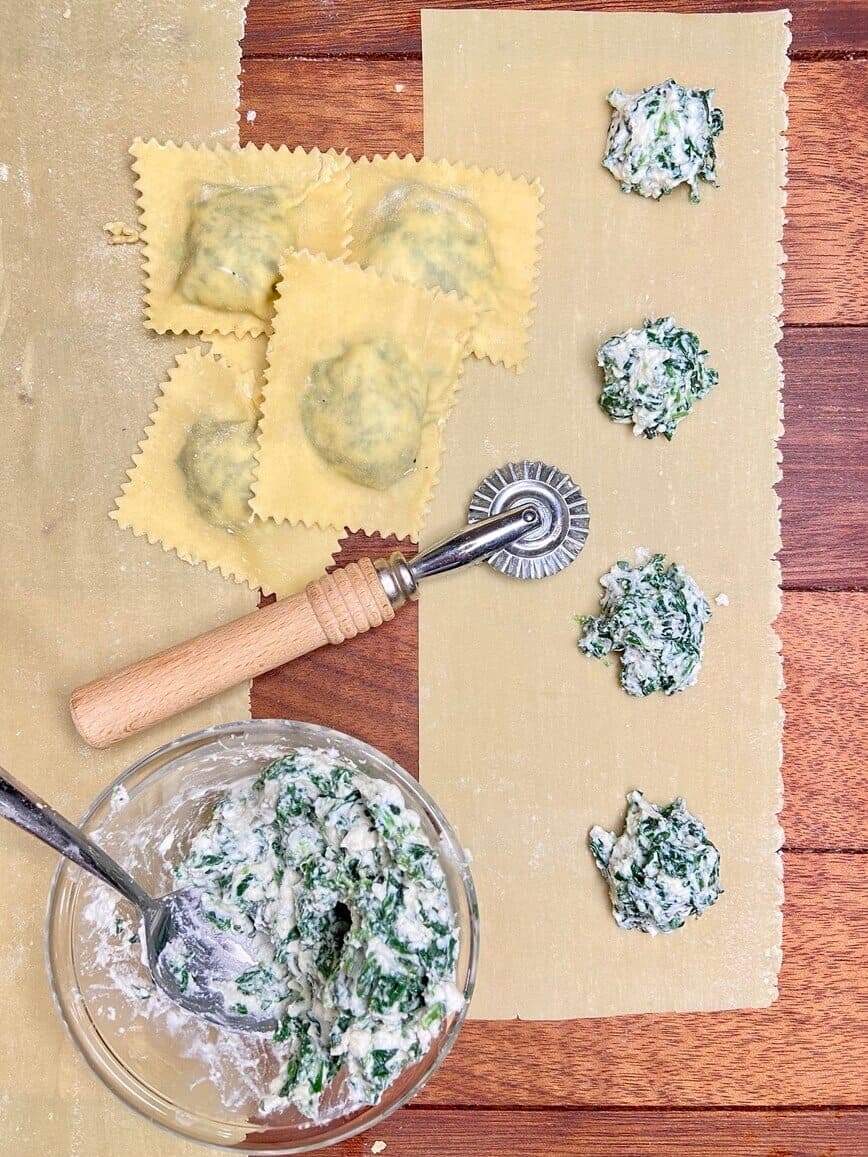
Lightly spritz the long edge of the dough with water. This will help the dough to stick to itself when you fold it. Fold the dough in half. Gently press down around each scoop of filling, trying to remove as much air as possible. This will help the ravioli cook more evenly. Don’t worry if they all look a little different. As said before, that’s the fun of it. It makes them “authentic”
Next, use a knife or one of those cool ravioli wheels to cut the raviolis. Congratulations! You just made your own homemade pasta from scratch. Your friends will be mighty impressed.
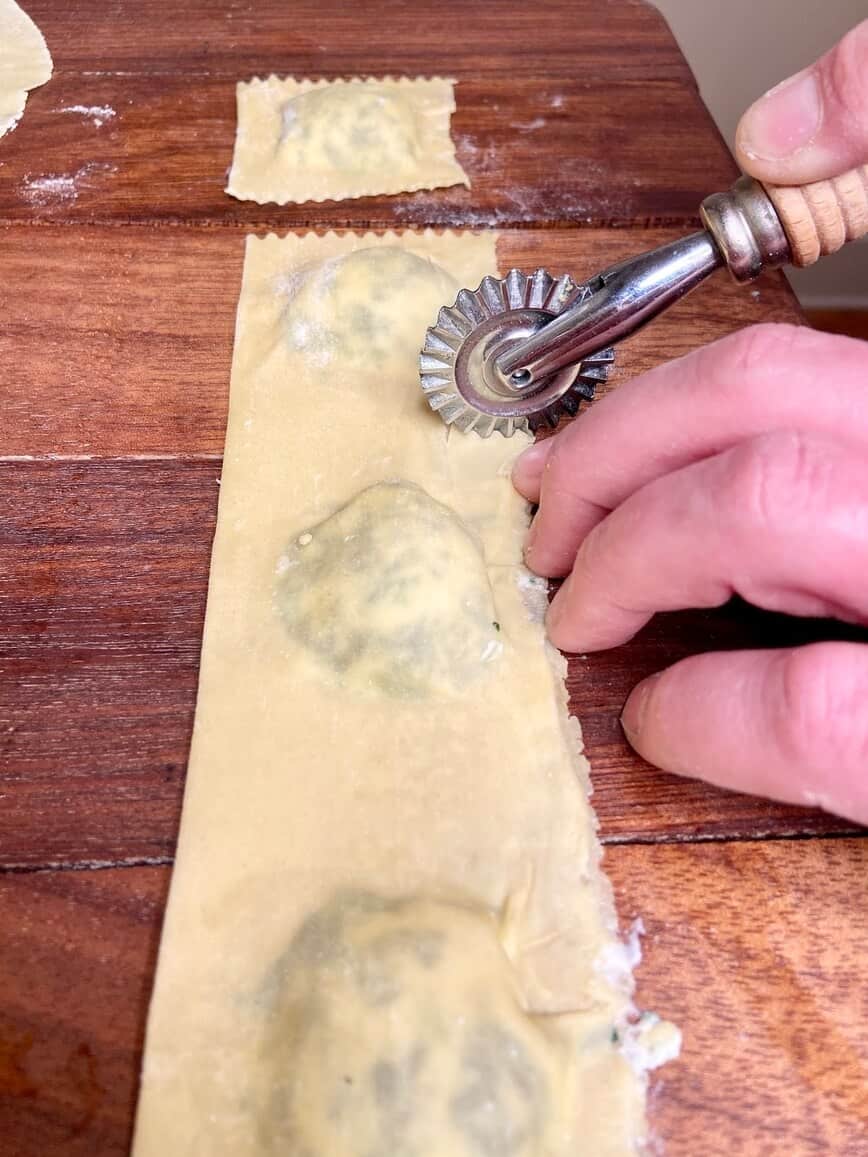
⭐ Tip: When cooking these ravioli in regular salted pasta water, make sure not to crowd them too much or they’ll cook unevenly. As they only take a few minutes to cook, make them in batches if needed.
Because these homemade ravioli are pretty delicate when cooked, I recommend using a handy food spider to remove them from the pasta pot instead of draining them in a colander.
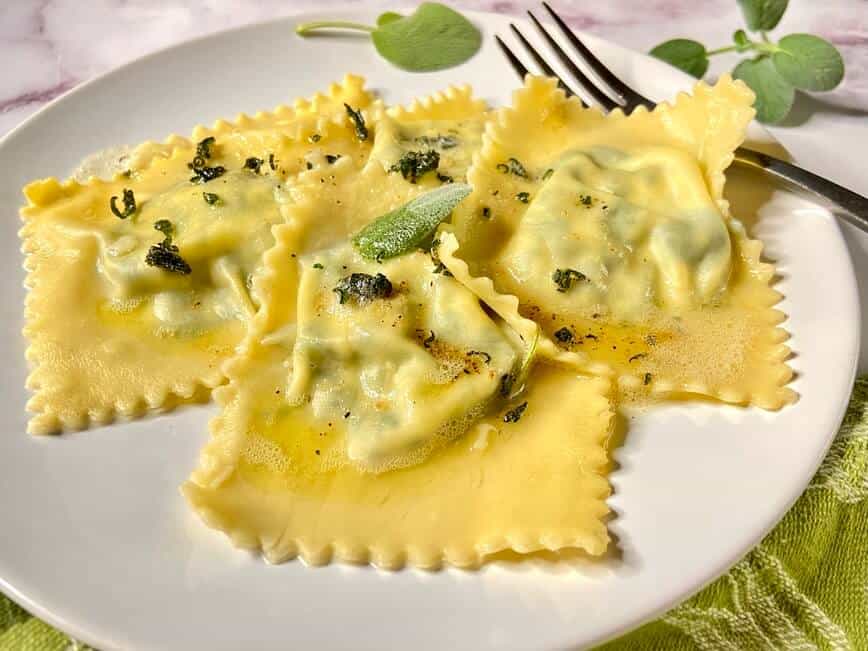
🧈 Ingredients for the sauce
- Unsalted butter
- Fresh sage leaves
- Salt and pepper
See the recipe card below for full list of ingredients and their measurements.
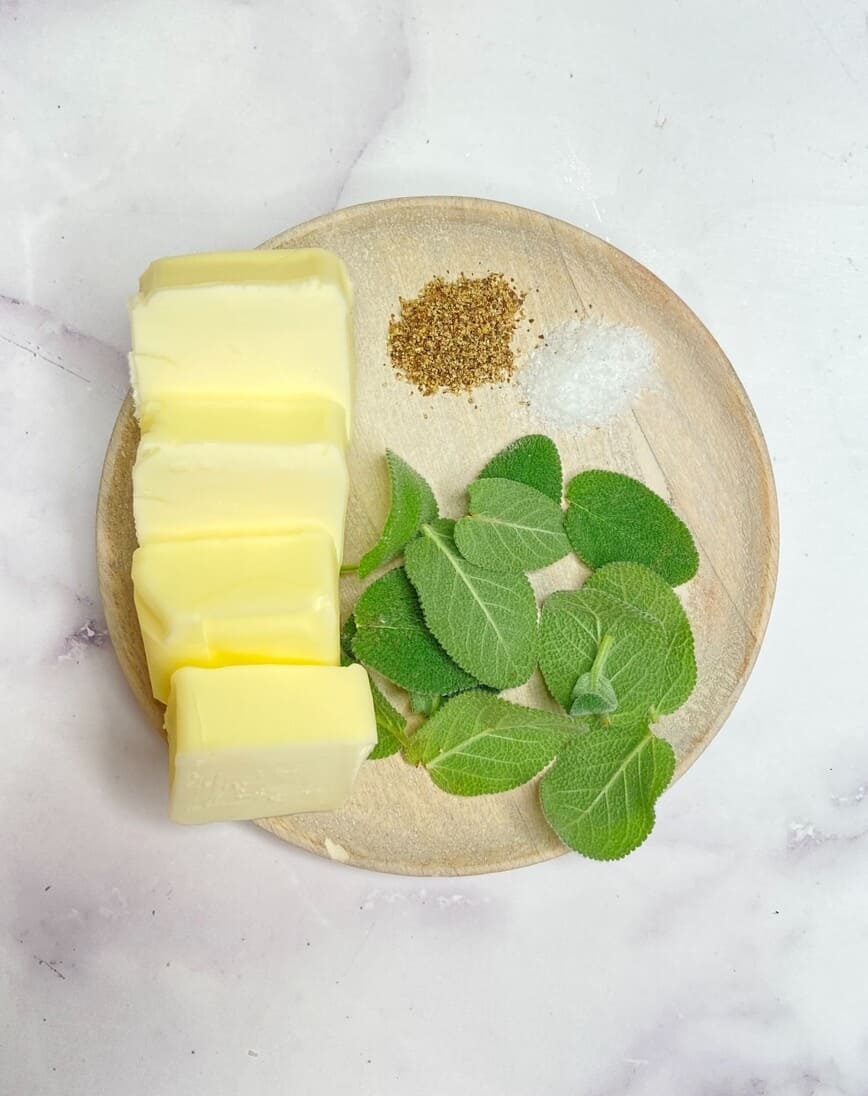
🌿 How to make sage butter sauce
Making sage butter sauce starts out with a French classic: Beurre noisette (literally meaning hazelnut butter). It’s simply heated, unsalted butter. But you have to agree that beurre noisette does sound fancier.
This rich, nutty tasting sauce is (funny enough for a French origin) used in a lot of classic northern Italian dishes. Adding some roughly chopped sage and/or mushrooms makes this simple sauce a very versatile topper for any pasta dish like ravioli, gnocchi, or tortellini.
Just watch out: Once you start melting the butter, things happen fast and you’d better not answer the phone while the butter is bubbling or you’ll end up with burnt butter (beurre brûlé), which is not the same as crème brûlée….. 🤣
Melt the butter in a medium saucepan over low-medium heat. The butter will begin to bubble after a minute or so. Add salt, pepper, and sage and continue stirring and cooking for another 1 to 2 minutes until the butter turns a light brown. Taste it (careful, it will be very hot). It should have a rich, nutty flavor.
Drizzle over the ravioli.
✨ Tips for the sage butter sauce
- Use unsalted butter if possible. Salted butter foams up quicker which makes it harder to discern the color change when it changes to light brown.
- Make sure to cut the butter in smaller (teaspoon-size) pieces before adding to the pot. This will help it brown evenly. Starting out with a whole stick could burn some of the butter before browning the rest.
😃 Fun facts about ravioli
- The earliest known mention of ravioli appears in the personal letters of Francesco di Marco Datini, a merchant of Prato in the 14th century.
- In Venice, the mid-14th-century manuscript Libro per Cuoco offers ravioli of green herbs blanched and minced, mixed with beaten egg and fresh cheese, simmered in broth and seasoned with “sweet and strong spices.”
- In Rome, ravioli were already well-known when Bartolomeo Scappi served them with boiled chicken to the papal conclave of 1549.
- Ravioli were already known in 14th century England, appearing in the Anglo-Norman vellum manuscript Forme of Cury, under the name of rauioles.
- Maltese ravjul are stuffed with irkotta, the locally produced sheep’s-milk ricotta, or with gbejna, the traditional fresh sheep’s-milk cheese.
- In Rome and Latium, the filling is made with ricotta cheese, spinach, nutmeg, and black pepper. In Sardinia, ravioli are filled with ricotta and grated lemon rind.
- “Fresh” packed ravioli have, in Europe and the United States, several weeks of shelf life. Canned ravioli was pioneered by the Italian Army in World War I and was popularized by Heinz and Buitoni in the UK and Europe, and Chef Boyardee in the United States.
- Toasted ravioli (ravioli that have been breaded and deep fried) was developed in St. Louis, Missouri, and is a popular appetizer or snack food.
- Ravioli are commonly encountered in the cooking of Nice, the broader Côte d’Azur, and the surrounding regions in the south of France.
- In Turkey, Mantı, which is similar to ravioli, is a popular dish. It is stuffed with spiced meat and served with paprika sauce and yoghurt.
- Similar dishes in China are the jiaozi or wonton. Also, the Asian dish samosa is similar to ravioli and is stuffed with potato, meat, peas, or paneer, and often served with sweet and sour sauce.
- In India, a popular dish called gujiya is similar to ravioli. However, it is prepared sweet, with a filling of dry fruits, sugar, and a mixture of sweet spices, then deep fried in vegetable oil.
- Jewish cuisine has a similar dish called kreplach, a pocket-oli of meat or other filling, with an egg pasta based covering. It is simmered in chicken soup.
- A similar Middle Eastern dish called shishbarak contains pasta filled with minced beef meat and cooked in hot yogurt.

Looking for more delicious pasta dinner ideas? Check out a few more of our recipes now:
- Crispy Ravioli Formaggi
- Spicy Garlic Noodles
- Baked Ziti with Ricotta and Italian Sausage
- Linguine with Clams – Linguine alle Vongole
- Shrimp Scampi with Garlic and Lemon
- 4 Ingredient Cacio e Pepe
- Shrimp Fettuccine Alfredo
- One Pot Sausage Meatballs with Pasta
- Butternut Squash Pasta
Did you make this Homemade Spinach Ricotta Ravioli with Butter Sage Sauce? Let us know in the comments below!
📝 Recipe
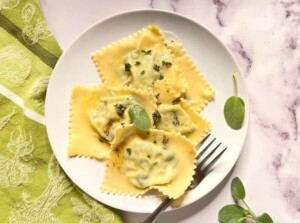
Homemade Spinach Ricotta Ravioli with Sage Butter Sauce
Ingredients
Pasta
- 1 cup all purpose flour
- 1 large egg + 2 yolks
- ½ teaspoon kosher salt
- 1 teaspoon extra virgin olive oil
Spinach Ricotta (and Parmesan cheese) Filling
- 1 tablespoon extra virgin olive oil
- 5 ounces fresh spinach, washed and trimmed
- ¾ cup whole milk ricotta
- ½ cup grated Parmigiano Reggiano
- ½ teaspoon kosher salt
- ¼ teaspoon freshly cracked black pepper
Sage Butter Sauce
- 1 stick unsalted butter
- ½ teaspoon kosher salt
- ½ teaspoon freshly cracked black pepper
- ¼ cup fresh sage leaves, roughly chopped
Instructions
Pasta
- Start by sifting the flour onto the surface.
- Create a well on top of the flour and crack an egg into it.
- Also, lightly whisk two egg yolks in a small bowl and have them ready.
- Add the salt into the well and start mixing carefully with a fork, trying to keep the egg from running out of the well.
- Once the first egg is mostly incorporated into the flour, add the olive oil and the two egg yolks.
- At this point, I like to use a food scraper to help work the flour toward the center to mix the dough until the egg yolks are mostly absorbed.
- Next, sprinkle some flour into your hands and knead for about 3 minutes.
- Wrap in cling wrap and let rest at room temperature for about 30 minutes.
- Next, cut the dough into quarters.
- Flatten each piece of dough slightly by pressing down with the palm of your hand and form it into a rectangular shape that will fit the width of the machine.
- Set the rollers to the widest setting and roll the dough through. Keep rolling the dough through the pasta maker, passing it through each setting twice. Keep decreasing the setting until reaching your desired thickness. In the case of ravioli, you want to make sure to get to the smallest, thinnest setting, as the dough will be doubled when you fold it over.
Spinach Ricotta (and Parmesan cheese) Filling
- Use a pan that’s large enough to fit the fresh spinach.
- Heat olive oil over medium heat and add the spinach.
- Within a couple minutes – while stirring occasionally – your fresh spinach will shrink from a couple handfuls to less than a cup.
- When the spinach is cooked down, place in a colander and squeeze out as much water as you can. In addition to that, I place the spinach onto some paper towels to remove some more moisture.
- Finely chop the spinach.
- Place the spinach in a bowl, together with the ricotta, Parmesan, salt, and pepper, and mix it all together.
- Taste and add more salt and/or pepper if necessary. The way your filling tastes right now is pretty much how your ravioli (without sauce) will taste.
How to Make Homemade Ravioli
- Place about 2 teaspoon of filling on the bottom half of the dough sheet. Leave about 1-½” of space between each scoop of filling.
- Lightly spritz the long edge of the dough with water. This will help the dough to stick to itself when you fold it.
- Fold the dough in half.
- Gently press down around each scoop of filling, trying to remove as much air as possible. This will help the ravioli cook more evenly.
- Next, use a knife or one of those cool ravioli wheels to cut the raviolis.
Sage Butter Sauce
- Melt the butter in a medium saucepan over low-medium heat. The butter will begin to bubble after a minute or so.
- Add salt, pepper, and sage and continue stirring and cooking for another 1 to 2 minutes until the butter turns a light brown. Taste it (careful, it will be very hot). It should have a rich, nutty flavor.
Putting it all together
- Cook ravioli in regular salted pasta water, brought to a boil, making sure not to crowd them too much or they’ll cook unevenly. As they only take a few minutes to cook, make them in batches if needed.
- Because these homemade ravioli are pretty delicate when cooked, I recommend using a handy food spider to remove them from the pasta pot instead of draining them in a colander.
- Drizzle sage butter sauce over the ravioli. Serve and enjoy!
Notes

Content and photographs are copyright protected. Sharing of this recipe is both encouraged and appreciated. Copying and/or pasting full recipes to any social media is strictly prohibited.


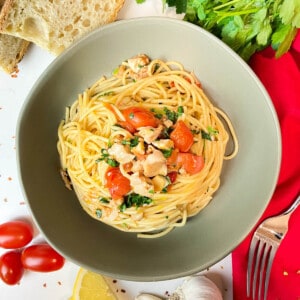

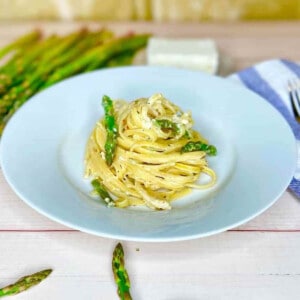
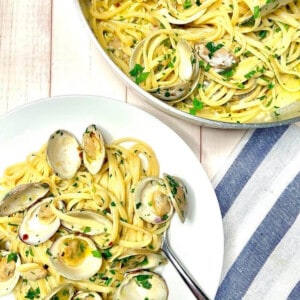
Leah Buehler
This sounds AMAZING! And like I will be addicted to it right away haha this is my favorite kind of ravioli.
maplewoodroad
Awesome! Enjoy! 🙂
Erika Ravnsborg
Wow that ravioli looks really yummy!
maplewoodroad
Thanks! 🙂